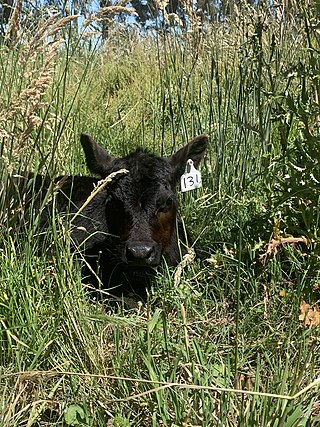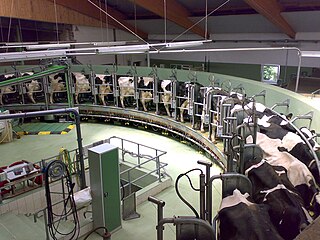Related Research Articles

A calf is a young domestic cow or bull. Calves are reared to become adult cattle or are slaughtered for their meat, called veal, and their hide.

Veal is the meat of calves, in contrast to the beef from older cattle. Veal can be produced from a calf of either sex and any breed; however, most veal comes from young male calves of dairy breeds which are not used for breeding. Generally, veal is more expensive by weight than beef from older cattle. Veal production is a way to add value to dairy bull calves and to utilize whey solids, a byproduct from the manufacturing of cheese.

Weaning is the process of gradually introducing an infant human or another mammal to what will be its adult diet while withdrawing the supply of its mother's milk.

The Holstein Friesian is an international breed or group of breeds of dairy cattle. It originated in the Dutch provinces of North Holland and Friesland and in Schleswig-Holstein in northern Germany. It is the dominant breed in industrial dairy farming worldwide, and is found in more than 160 countries. It is known by many names, among them Holstein, Friesian and Black and White.

Dairy farming is a class of agriculture for long-term production of milk, which is processed for eventual sale of a dairy product. Dairy farming has a history that goes back to the early Neolithic era, around the seventh millennium BC, in many regions of Europe and Africa. Before the 20th century, milking was done by hand on small farms. Beginning in the early 20th century, milking was done in large scale dairy farms with innovations including rotary parlors, the milking pipeline, and automatic milking systems that were commercially developed in the early 1990s.

A feedlot or feed yard is a type of animal feeding operation (AFO) which is used in intensive animal farming, notably beef cattle, but also swine, horses, sheep, turkeys, chickens or ducks, prior to slaughter. Large beef feedlots are called concentrated animal feeding operations (CAFO) in the United States and intensive livestock operations (ILOs) or confined feeding operations (CFO) in Canada. They may contain thousands of animals in an array of pens.

Dairy cattle are cattle bred for the ability to produce large quantities of milk, from which dairy products are made. Dairy cattle generally are of the species Bos taurus.

There are different systems of feeding cattle in animal husbandry. For pastured animals, grass is usually the forage that composes the majority of their diet. Cattle reared in feedlots are fed hay supplemented with grain, soy and other ingredients to increase the energy density of the feed. The debate is whether cattle should be raised on fodder primarily composed of grass or a concentrate. The issue is complicated by the political interests and confusion between labels such as "free range", "organic", or "natural". Cattle raised on a primarily foraged diet are termed grass-fed or pasture-raised; for example meat or milk may be called grass-fed beef or pasture-raised dairy. The term "pasture-raised" can lead to confusion with the term "free range", which does not describe exactly what the animals eat.

A foal is an equine up to one year old; this term is used mainly for horses, but can be used for donkeys. More specific terms are colt for a male foal and filly for a female foal, and are used until the horse is three or four. When the foal is nursing from its dam (mother), it may also be called a "suckling". After it has been weaned from its dam, it may be called a "weanling". When a mare is pregnant, she is said to be "in foal". When the mare gives birth, she is "foaling", and the impending birth is usually stated as "to foal". A newborn horse is "foaled".
In animal husbandry, feed conversion ratio (FCR) or feed conversion rate is a ratio or rate measuring of the efficiency with which the bodies of livestock convert animal feed into the desired output. For dairy cows, for example, the output is milk, whereas in animals raised for meat the output is the flesh, that is, the body mass gained by the animal, represented either in the final mass of the animal or the mass of the dressed output. FCR is the mass of the input divided by the output. In some sectors, feed efficiency, which is the output divided by the input, is used. These concepts are also closely related to efficiency of conversion of ingested foods (ECI).

Beef cattle are cattle raised for meat production. The meat of mature or almost mature cattle is mostly known as beef. In beef production there are three main stages: cow-calf operations, backgrounding, and feedlot operations. The production cycle of the animals starts at cow-calf operations; this operation is designed specifically to breed cows for their offspring. From here the calves are backgrounded for a feedlot. Animals grown specifically for the feedlot are known as feeder cattle, the goal of these animals is fattening. Animals not grown for a feedlot are typically female and are commonly known as replacement heifers. While the principal use of beef cattle is meat production, other uses include leather, and beef by-products used in candy, shampoo, cosmetics, and insulin.

Soybean meal is used in food and animal feeds, principally as a protein supplement, but also as a source of metabolizable energy. Typically 1 bushel of soybeans yields 48 lbs. (21.8 kg) of soybean meal. Soybean meal is produced as a co-product of soybean oil extraction. Some, but not all, soybean meal contains ground soybean hulls. Soybean meal is heat-treated during production, to denature the trypsin inhibitors of soybeans, which would otherwise interfere with protein digestion.

Animal feed is food given to domestic animals, especially livestock, in the course of animal husbandry. There are two basic types: fodder and forage. Used alone, the word feed more often refers to fodder. Animal feed is an important input to animal agriculture, and is frequently the main cost of the raising or keeping of animals. Farms typically try to reduce cost for this food, by growing their own, grazing animals, or supplementing expensive feeds with substitutes, such as food waste like spent grain from beer brewing.

Pig farming or pork farming or hog farming is the raising and breeding of domestic pigs as livestock, and is a branch of animal husbandry. Pigs are farmed principally for food and skins.
Livestock grazing comparison is a method of comparing the numbers and density of livestock grazing in agriculture. Various units of measurement are used, usually based on the grazing equivalent of one adult cow, or in some areas on that of one sheep. Many different schemes exist, giving various values to the grazing effect of different types of animal.
The concept of an animal unit (AU) has traditionally been used in North America to facilitate planning, analysis and administration of forage use by grazing livestock, but the term has also had other applications. The term has been variously defined by regulation in different jurisdictions, and by livestock management specialists, rangeland resource managers and others. Consequently, when using or interpreting the term, care is needed to ensure that a definition appropriate for the purpose is being used. Most definitions are based on the concept that a 1000-pound (454 kg) cow, with or without an unweaned calf, is one animal unit, with such a cow being assumed to consume 26 pounds of forage dry matter per day.

Feeder cattle, in some countries or regions called store cattle, are young cattle mature enough either to undergo backgrounding or to be fattened in preparation for slaughter. They may be steers or heifers. The term often implicitly reflects an intent to sell to other owners for fattening (finishing). Backgrounding occurs at backgrounding operations, and fattening occurs at a feedlot. Feeder calves are less than 1 year old; feeder yearlings are between 1 and 2 years old. Both types are often produced in a cow-calf operation. After attaining a desirable weight, feeder cattle become finished cattle that are sold to a packer. Packers slaughter the cattle and sell the meat in carcass boxed form.

Cattle or oxen are large, domesticated, bovid ungulates. They are prominent modern members of the subfamily Bovinae and the most widespread species of the genus Bos. Mature female cattle are referred to as cows and mature male cattle are referred to as bulls. Colloquially, young female cattle (heifers), young male cattle (bullocks), and castrated male cattle (steers) are also referred to as "cows".
Expected progeny differences (EPD) are an evaluation of an animal’s genetic worth as a parent. They are based on animal models which combine all information known about an individual and its relatives to create a genetic profile of the animal’s merits. These profiles are then compared to other individuals of the same breed.

A cow calf operation is a method of rearing beef cattle in which a permanent herd of cows is kept by a farmer or rancher to produce calves for later sale. Cow–calf operations are one of the key aspects of the beef industry in the United States and many other countries. In the British Isles, a cow–calf operation may be known as a single-suckler herd. The goal of a cow–calf operation is to produce young beef cattle, which are usually sold. A rancher who works within such a model is often called a "cow–calf operator" in the United States.
References
- 1 2 3 4 5 6 7 8 9 10 11 12 13 14 Eversole, Dan E. "Creep Feeding Beef Calves". Virginia Cooperative Extension. Virginia Tech. Retrieved 2013-06-21.
- 1 2 "Creep Feeding". The Pig Site. March 21, 2013. Retrieved 2013-06-21.
- 1 2 3 4 5 6 7 8 9 Rasby, Richard J.; Niemeyer, Steven W. "Creep Feeding Beef Calves". NebGuide. University of Nebraska. Archived from the original on 2013-06-24. Retrieved 2013-06-22.
- 1 2 Berg, Lara (Mar 15, 2008). "Use Pig Age to Guide Creep Feeding". National Hog Farmer. Retrieved 2013-06-22.
- ↑ "Creep Feed". America's Horse Daily. The American Quarter Horse Journal. May 22, 2009. Archived from the original on June 24, 2013. Retrieved 2013-06-22.